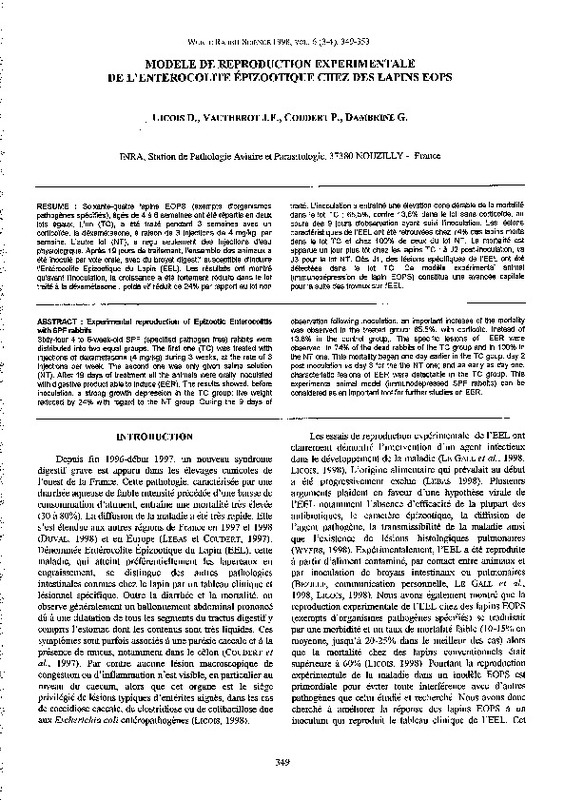JavaScript is disabled for your browser. Some features of this site may not work without it.
Buscar en RiuNet
Listar
Mi cuenta
Estadísticas
Ayuda RiuNet
Admin. UPV
MODELE DE REPRODUCTION EXPERIMENTALE DE L'ENTEROCOLITE EPIZOOTIQUE CHEZ DES LAPINS EOPS
Mostrar el registro sencillo del ítem
Ficheros en el ítem
| dc.contributor.author | LICOIS, D.
|
|
| dc.contributor.author | VAUTHEROT, J.F.
|
|
| dc.contributor.author | COUDERT, P.
|
|
| dc.contributor.author | DAMBRINE, G.
|
|
| dc.date.accessioned | 2011-03-14T12:24:42Z | |
| dc.date.available | 2011-03-14T12:24:42Z | |
| dc.date.issued | 1998 | |
| dc.identifier.issn | 1257-5011 | |
| dc.identifier.uri | http://hdl.handle.net/10251/10327 | |
| dc.description.abstract | [EN] Sixty-four 4 to 6-week-old SPF (specified pathogen free) rabbits were distributed into two equal groups. The first one (TC) was treated with injections of dexametasone (4 mg/kg) during 3 weeks, at the rate of 3 injections per week. The second one was only given satine solution (NT). After 19 days of treatment all the animals were orally inoculated with digestive product able to induce (EER). The results showed, before inoculation, a strong growth depression in the TC group: live weight reduced by 24% with regard to the NT group. During the 9 days of observation following inoculation, an important increase of the mortality was observed in the treated group: 65.5%, with corticold, instead of 13.8% in the control group,. The specific lesions of EER were observed in 74% of the dead rabbits of the TC group and in 100% in the NT one. This mortality began one day earlier in the TC goup: day 2 post inoculation vs day 3 for the the NT one; and as early as day one, characteristic lesions of EER were detectable in the TC group. This experimental animal model (immunodepressed SPF rabbits) can be considerad as an important too! for further studies on EER. | es_ES |
| dc.description.abstract | [FR] Soixante-quatre lapins EOPS (exempts d'organismes pathogénes spécifiés), agés de 4 a 6 semaines ont été répartis en deux lots égaux. L'un (TC), a été traité pendant 3 semaines avec un corticolde, la déxamétasone, a raison de 3 injections de 4 mg/kg, par semaine. L'autre lot (NT), a r~u seulement des injections d'eau physiologique. Aprés 19 jours de traitement, !'ensemble des animaux a été inoculé par voie orate, avec du broyat digestif susceptible d'induire l'Entérocolite Epizootique du Lapin (EEL). Les résultats ont montré qu'avant l'inoculation, la croissance a été fortement réduite dans le lot traité a la déxamétasone : poids vif réduit de 24% par rapport au lot non traité. L'inoculation a entrafné une élévation considérable de la mortalité dans le lot TC : 65,5%, contre 13,8% dans le lot sans corticoYde, au cours des 9 jours d'observation ayant suivi l'inoculation. Les lésions caractéristiques de l'EEL ont été retrouvées chez 74% des lapins morts dans le lot TC et chez 100% de ceux du lot NT. La mortalité est apparue un jour plus tOt chez les lapins TC : a J2 post-inoculation, vs J3 pour le lot NT. Dés J1, des lésions spécifiques de l'EEL ont été détectées dans le lot TC. Ce modele expérimental animal (immunodépression de lapin EOPS) constitue une avancée capitale pour la suite des travaux sur l'EEL. | |
| dc.language | Inglés | es_ES |
| dc.publisher | World Rabbit Science. ICTA. UPV | es_ES |
| dc.relation.ispartof | World Rabbit Science | |
| dc.rights | Reserva de todos los derechos | es_ES |
| dc.title | MODELE DE REPRODUCTION EXPERIMENTALE DE L'ENTEROCOLITE EPIZOOTIQUE CHEZ DES LAPINS EOPS | es_ES |
| dc.type | Artículo | es_ES |
| dc.date.updated | 2011-03-14T11:50:28Z | |
| dc.identifier.doi | 10.4995/wrs.1998.367 | |
| dc.rights.accessRights | Abierto | es_ES |
| dc.description.bibliographicCitation | Licois, D.; Vautherot, J.; Coudert, P.; Dambrine, G. (1998). MODELE DE REPRODUCTION EXPERIMENTALE DE L'ENTEROCOLITE EPIZOOTIQUE CHEZ DES LAPINS EOPS. World Rabbit Science. 6(3-4). https://doi.org/10.4995/wrs.1998.367 | es_ES |
| dc.description.accrualMethod | SWORD | es_ES |
| dc.relation.publisherversion | https://doi.org/10.4995/wrs.1998.367 | |
| dc.description.volume | 6 | |
| dc.description.issue | 3-4 | |
| dc.identifier.eissn | 1989-8886 | es_ES |








